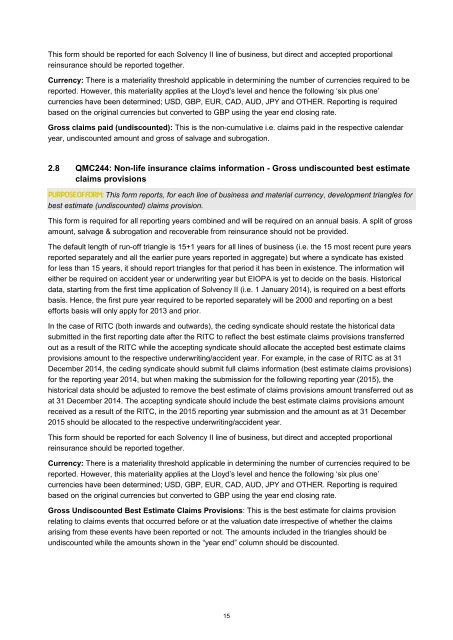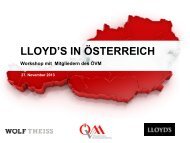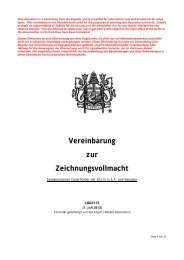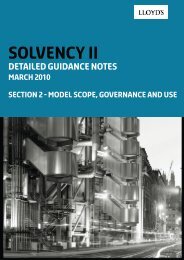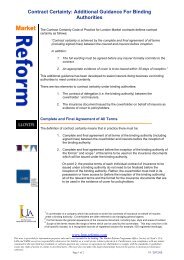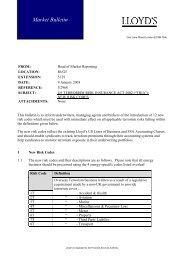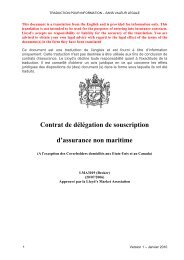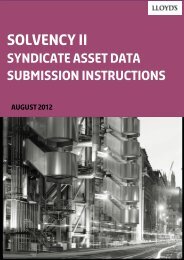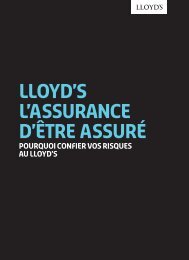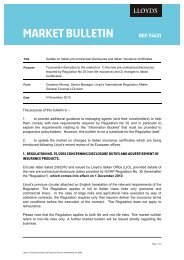You also want an ePaper? Increase the reach of your titles
YUMPU automatically turns print PDFs into web optimized ePapers that Google loves.
This form should be reported for each <strong>Solvency</strong> <strong>II</strong> line of business, but direct and accepted proportional<br />
reinsurance should be reported together.<br />
Currency: There is a materiality threshold applicable in determining the number of currencies required to be<br />
reported. However, this materiality applies at the Lloyd’s level and hence the following ‘six plus one’<br />
currencies have been determined; USD, GBP, EUR, CAD, AUD, JPY and OTHER. Reporting is required<br />
based on the original currencies but converted to GBP using the year end closing rate.<br />
Gross claims paid (undiscounted): This is the non-cumulative i.e. claims paid in the respective calendar<br />
year, undiscounted amount and gross of salvage and subrogation.<br />
2.8 QMC244: Non-life insurance claims information - Gross undiscounted best estimate<br />
claims provisions<br />
Purpose of form: This form reports, for each line of business and material currency, development triangles for<br />
best estimate (undiscounted) claims provision.<br />
This form is required for all reporting years combined and will be required on an annual basis. A split of gross<br />
amount, salvage & subrogation and recoverable from reinsurance should not be provided.<br />
The default length of run-off triangle is 15+1 years for all lines of business (i.e. the 15 most recent pure years<br />
reported separately and all the earlier pure years reported in aggregate) but where a syndicate has existed<br />
for less than 15 years, it should report triangles for that period it has been in existence. The information will<br />
either be required on accident year or underwriting year but EIOPA is yet to decide on the basis. Historical<br />
data, starting from the first time application of <strong>Solvency</strong> <strong>II</strong> (i.e. 1 January 2014), is required on a best efforts<br />
basis. Hence, the first pure year required to be reported separately will be 2000 and reporting on a best<br />
efforts basis will only apply for 2013 and prior.<br />
In the case of RITC (both inwards and outwards), the ceding syndicate should restate the historical data<br />
submitted in the first reporting date after the RITC to reflect the best estimate claims provisions transferred<br />
out as a result of the RITC while the accepting syndicate should allocate the accepted best estimate claims<br />
provisions amount to the respective underwriting/accident year. For example, in the case of RITC as at 31<br />
December 2014, the ceding syndicate should submit full claims information (best estimate claims provisions)<br />
for the reporting year 2014, but when making the submission for the following reporting year (2015), the<br />
historical data should be adjusted to remove the best estimate of claims provisions amount transferred out as<br />
at 31 December 2014. The accepting syndicate should include the best estimate claims provisions amount<br />
received as a result of the RITC, in the 2015 reporting year submission and the amount as at 31 December<br />
2015 should be allocated to the respective underwriting/accident year.<br />
This form should be reported for each <strong>Solvency</strong> <strong>II</strong> line of business, but direct and accepted proportional<br />
reinsurance should be reported together.<br />
Currency: There is a materiality threshold applicable in determining the number of currencies required to be<br />
reported. However, this materiality applies at the Lloyd’s level and hence the following ‘six plus one’<br />
currencies have been determined; USD, GBP, EUR, CAD, AUD, JPY and OTHER. Reporting is required<br />
based on the original currencies but converted to GBP using the year end closing rate.<br />
Gross Undiscounted Best Estimate Claims Provisions: This is the best estimate for claims provision<br />
relating to claims events that occurred before or at the valuation date irrespective of whether the claims<br />
arising from these events have been reported or not. The amounts included in the triangles should be<br />
undiscounted while the amounts shown in the “year end” column should be discounted.<br />
15


